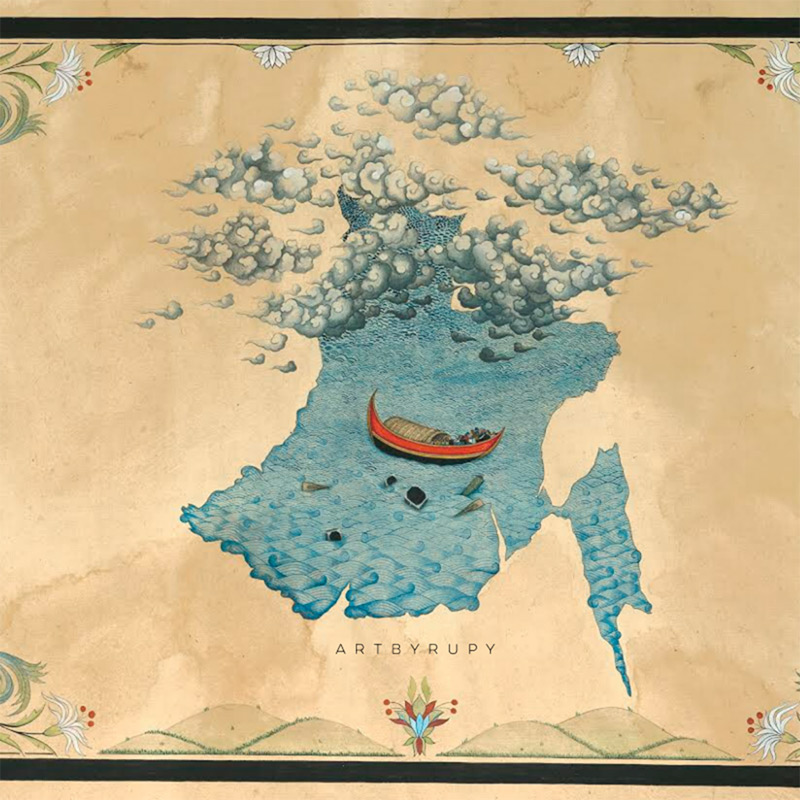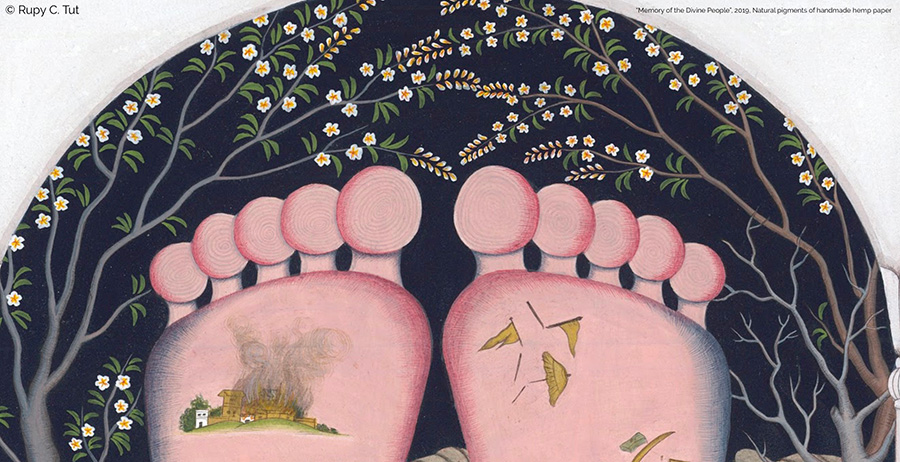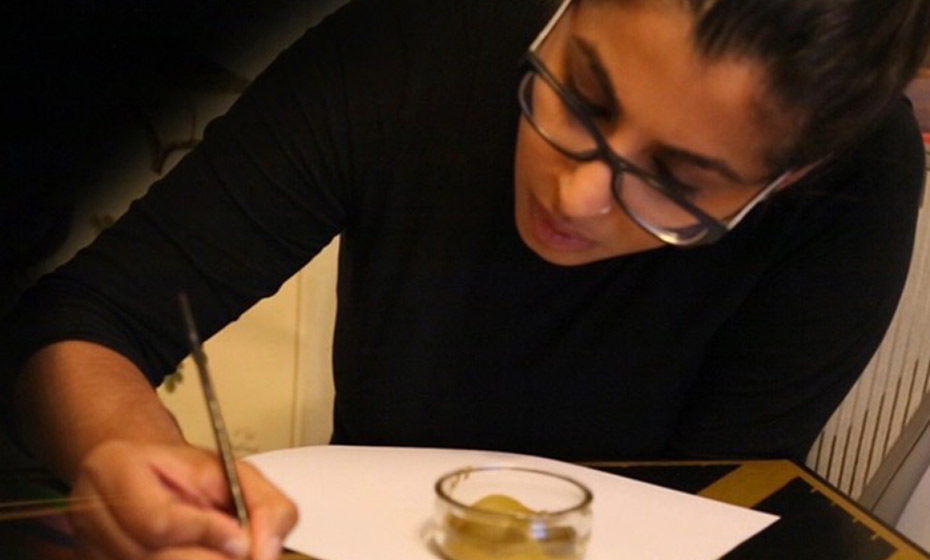Interview by Mehar Nijjar
Rupy C Tut is an Oakland based artist who uniquely combines the two traditions of miniature painting and calligraphy. With roots in India, Tut’s art challenges what it means to embody more than one identity. Her work has been presented in notable venues including Stanford University, London City Hall, and the Asian Art Museum in San Francisco. She is one of the six artists featured in Expressions of Divinity, an exhibit of contemporary Sikh art organized by the Sikh Foundation and Ik Onkar Bridges.
Mehar Nijjar converses with Tut about her influential background, her artwork, and her views on creativity and inspiration.
Q: What role does art play in your everyday life?
A: The role that art plays grows and evolves as I grow and evolve. Currently it’s more of a meditative and devotional practice.
Q: How long did your collection for Expressions of Divinity take to complete?
A: Since most of my works in Expressions of Divinity are new and recent, they have taken about 6 months to develop. About 6 months ago, I was invited to present work for the exhibition and since then ideas have been brewing in my mind and now, they have come to life.
Q: What is your favorite piece that you’ve created for this exhibit?
A: There isn’t one favorite piece but there are definitely specific parts of each painting that draw me in closer. Each painting expresses some very honest and important sentiments I wish to share with the world.

Q: Your past works have dealt with themes of immigration, identity, and gender equality. Can we expect similar themes in your current work?
A: Definitely. I think these themes are part of the fabric of life we life as conscious citizens of the world. For me, each of these topics is related on multiple levels. The influence of gender and personal identity of experiences related to movement or migration and vice versa all illuminate very unique aspects of the human experience. Through my work, I dissect the multiple layers of this human experience with immigration and identity with a female introspection.
Q: Is there a specific piece you want the audience to notice and understand in a certain way?
A: I feel each painting speaks to the audience in its own voice and pitch. I hope the audience can become closer to at least one or two aspects of each painting. Due to my extensive research behind each painting, I insert multiple symbolic elements into the composition. I hope the audience navigates these elements joyfully and finds a connection that is very personal and dear to them.
Q: What about miniature-style painting appeals to you?
A: Centuries old knowledge that guides both my practice and living is the most appealing aspect. The challenge of keeping a tradition alive with the challenge of keeping it individually connected to my life is another challenge that appeals strongly to me as an artist.
Q: Does your theme for your pieces come to you before or after you have created a collection? Does it matter?
A: I think the way you asked the question is the way it happens. Sometimes the theme or concept comes first and sometimes I’ll create three pieces and then the concept becomes more of a priority. It can vary with what’s happening in my life, what’s happening in the studio and honestly how much time I’m getting to think, read, and research.
Q: What is your target audience? In what ways do you hope to impact your audience?
A: I feel like the goal of my work is not necessarily to limit the audience at all, it’s always actually wonderful to reach out to people I wouldn’t otherwise expect to be seeing my work. I feel it’s a universal audience that I want to connect with and talk to. At the same time, I do feel a special connection to those who might have a similar concept of belonging or similar background as me because they might be able to recognize more of the symbolism I include in my work.
I always want people to see my work as something that they enjoy looking at. I want the work to catch their attention, kind of hold their hand, and bring them in deeper to the idea…the narrative I’m trying to share. A few moments of pause are what I would want the audience to take when they are looking at the work. I think sometimes those few moments of pause are what we are lacking in life.

Q: What advice do you have for aspiring artists who want to share their work, but don’t know how to get started on putting themselves out there?
A: I have a feeling that a lot of us who are creatively inclined get too worried about sharing our work with people or waiting for appreciation and hoping for some sort of acknowledgement from the world. However, we sometimes fail to focus as much energy on the work itself. As a budding artist, if you are focusing on what you are creating, what type of concepts you want to study, and what type of practice you want to have as an artist, then you shouldn’t be as worried about putting it out there for the world. I feel if there is integrity present in your work then you must share it with the world – whether it’s through social media or showing work at different events. Also, showing work is important but getting feedback that helps you create a better process is more important.
Q: In this exhibit, Expressions of Divinity, what is your motivation? How do you feel about the relationship between religion and artistic expression?
A: My larger motivation is for people to come see the work and identify this work with contemporary Sikh artistic expression. Whether the work is about history, religion, identity – whatever the focus is – I want people to start identifying art as one strong way to express the identity of a community.
I hope that the collective voice that’s being created with this show is encouraging for people to know the different types of voices that exist. I think the audience has a chance to connect to at least one or two voices, and hopefully follow them throughout their career.
For me, religion and artistic voice have been very much intertwined because both are very personal. Religion, and the way you practice and approach it, is very personal. Art is very much a personal practice. Even if you are selling your work and managing the business side of things, when you enter your studio, you are in an honest space at your most vulnerable, open, raw point in being. I think it’s very similar to religion.
At the same time, I don’t think there needs to be a separation of these different identities that we all embody. I don’t need to separate myself from my religion to be an artist, I don’t need to separate myself from my art to practice my religion. Somewhere, we have to accept that all of us are a mosaic of different influences, different goals and visions.
Q: What was your biggest learning experience in creating the pieces for this exhibit?
A: Always wanting more time. Next time, hopefully I would want to take a year or so to prepare for an exhibition versus a few months.
Q: You came of age in India, then moved to America to start a new chapter of your life. How did this shift in surroundings and culture affect your artistic approach?
A: My entire artistic approach is about how movement affects us, whether it’s movement by choice or whether we are being driven from our homes. Personally, I was able to connect to this other type of movement that was not by choice. I know how it feels to leave a place you know and that knows you as well, and also how it feels to go to a new place and figure out “How do I make this mine and how does it make me?”.
Somewhere I’m more fortunate because I have moved from one world to another and it gives me a unique perspective on belonging, on home, and on identity. I feel identity is very fluid and it can mean having an affinity for two different homelands – it doesn’t have to be just political or just geographical.
The climate that we’re in now forces you to ask yourself – “Do I really belong here? Is this really my home?”. When you have moved from one home to another – whether it’s by choice or not – you understand the meaning of home, and once you understand that meaning you fight for that home. South Asian American identity, Sikh American identity, Punjabi American identity – for me all these labels have become more important, because they encapsulate belonging and connection to multiple different things and not just one geographical place or nationality.
Q: Who/what is your biggest inspiration right now?
A: The struggle that we all face in life is individual to all of us, and then the fight we put up to face those struggles both are very inspiring processes for me to witness. I’ve seen those struggles and ways of fighting change from my grandparents to my parents and then to me. It’s really interesting, this process of being given challenges and how you face those challenges. How it changes and defines us is very inspirational to me.
Q: When did you realize you wanted to do art full-time?
A: After I had my first show, my first successful exhibition I felt I had something to say and felt committed to saying it through art, so I decided to do it full time. Almost 7 years ago.
Q: Identity seems to be a large part of the stories behind your artwork. How is art adding to your personal narrative?
A: I try not to make the mistake of making art my only identity. That’s one thing I’ve learned from exploring identity so much, that identity cannot be just your work and just what you’re known by. Having said that, art has enriched me greatly. It has made me fight for what I believe in and learn with patience and heart about a painting tradition that is so rare and difficult to practice. I think art has allowed me to unfold my personal narrative more vividly than I could imagine. Art has also made me a very passionate individual. I am someone who values hard work, persistence, skill and learning. All these values have become enriched after years of practicing art.
Q: Do you ever experience creative blocks? How do you then seek inspiration?
A: I don’t believe in creative blocks. I feel very lucky and fortunate to have the job of an artist. I have fought and sacrificed to have this job. For me, creative blocks might look like days when you are just trying a lot of ideas and nothing works out. Even that’s not a creative block, because the idea of a creative block implies that you are failing, at that moment, to produce anything at all. I disagree.
I think failing to produce is actually a step forward in producing good work. As an artist, that’s my job – to make my voice clearer, to build more skills, have more practice, and to create more work. Creative blocks are something I don’t think about, but yes, there are some days where I just have to sit down, read and research a lot, going through many ideas but not using a single one of them.
Q: What is your long-term goal with producing artwork?
A: The long-term goal is to produce work that is significant. The one expectation that I have from my work is that it should be better in some way than yesterday, and that it should speak to something that I find valuable. If others find that valuable, that’s amazing, but I think at the end of the day it just has to be something that I honestly and genuinely want to put out in the world and that I believe in, no matter what anybody thinks about it. Honest, ethical, value-based work is the long-term goal.
Rupy’s work can be seen in the exhibit, Expressions of Divinity, at the Triton Museum of Art in Santa Clara, California. The work is on display from August 31st to November 3rd, 2019.

